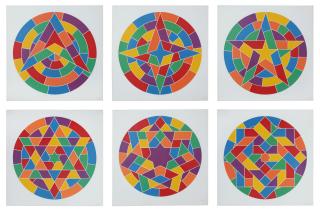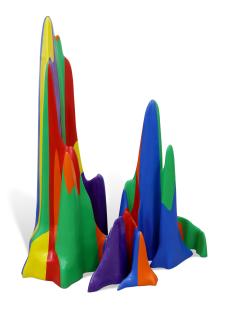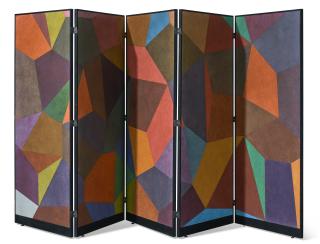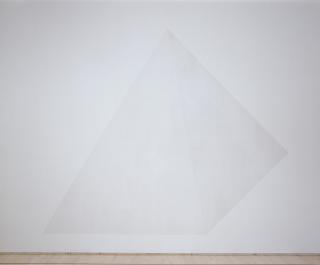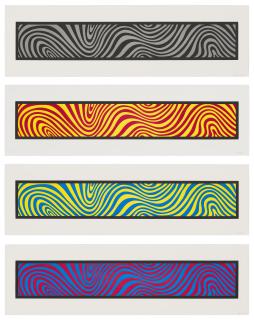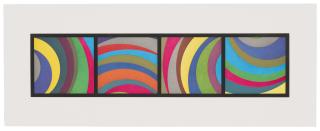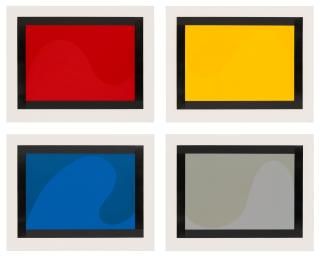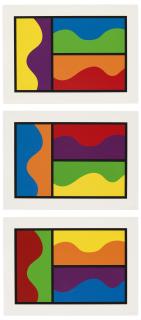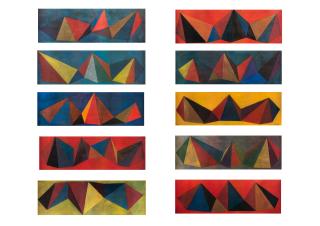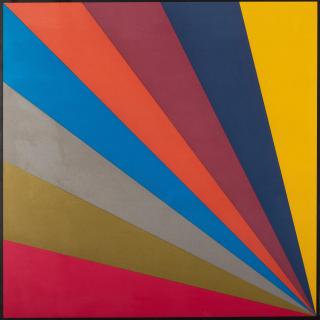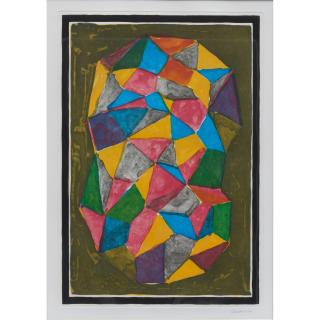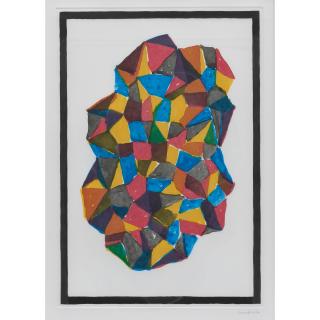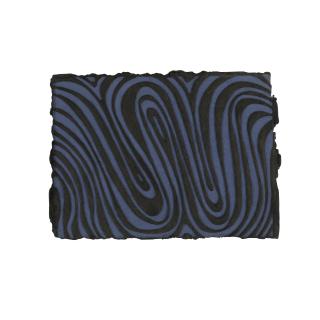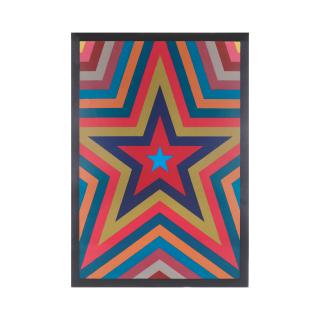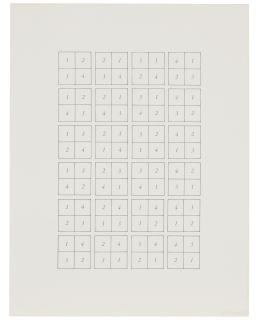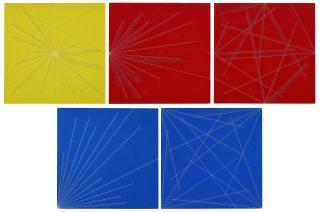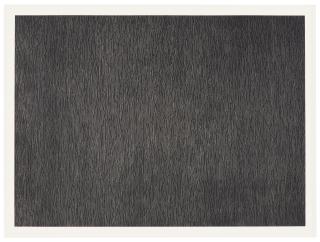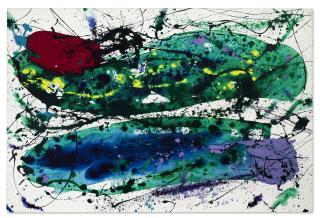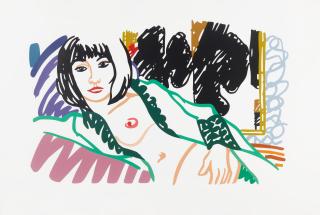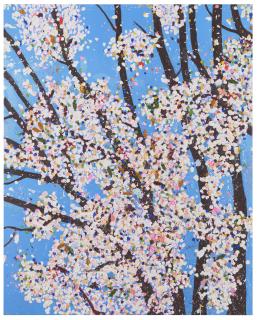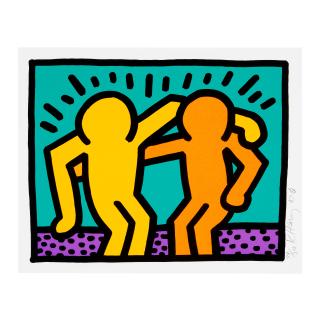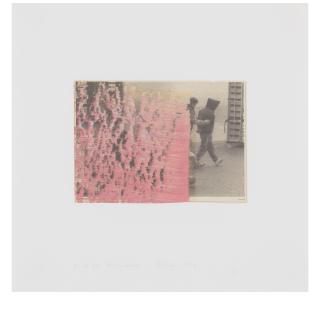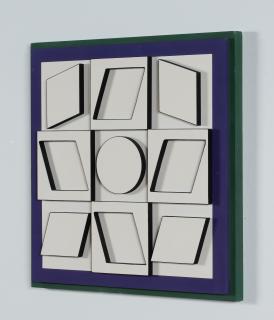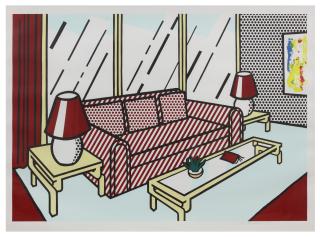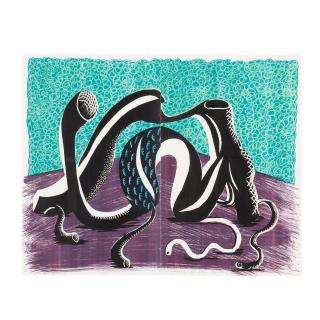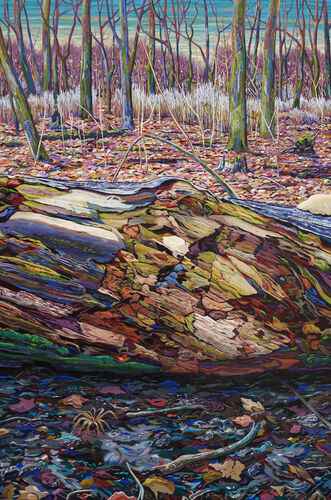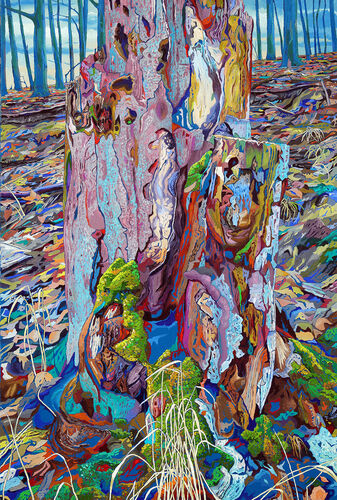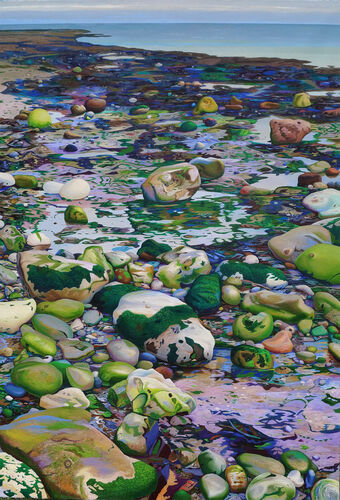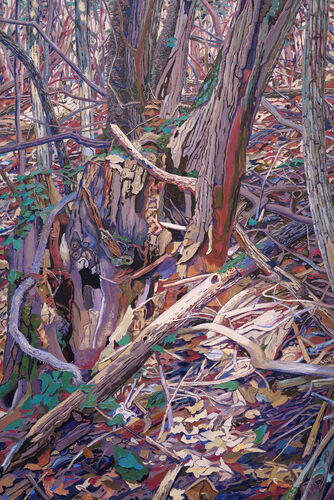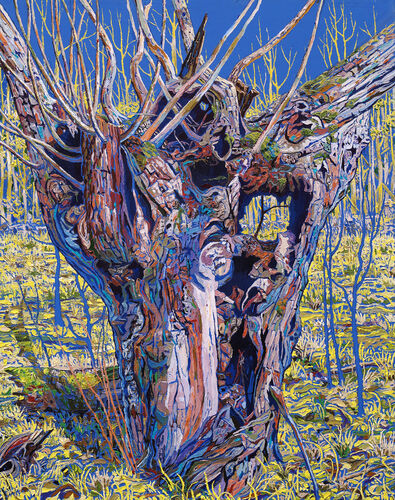Sol LeWitt Hartford, Connecticut 1928 - 2007 New York City
The artist Sol LeWitt
- Representative of minimalism and pioneer of conceptual art.
- Held a fascination for the serial representation of repetition.
- The idea that preceded his work was more important to him than the work itself.
Sol LeWitt, born 09.09.1928 in Hartford, Connecticut as Solomon LeWitt, deceased 08.04.2007 in New York, was an American Minimalist artist and pioneer of Conceptual Art. LeWitt was fascinated by series consisting of repetitions. One of his early sources of inspiration was the series of moving sequences in the works of the photographer Eadweard Muybridge. On the basis of these, he eventually created oil paintings, which, in addition to the photographic model, were above all influenced by LeWitt's enthusiasm for serial repetition.
He soon turned his attention to the cube as a form, which he tried to restage – this is how one of his most prominent works came into being: the Sculpture Series. The spatially arranged cubes, made of lattice bars and consisting of individual modules, resulted in a system as a whole. Later, LeWitt followed the sculptures with his now highly regarded large-scale, geometric and colourful wall paintings. He always created the Wall Drawings according to his systematic approach, for which he would later become known: The idea was always more important to him than the work itself.
Thus one of his most quoted statements is: »The idea becomes a machine that creates the art« – it is taken from his essay Paragraphs on Conceptual Art (1967). During his artistic development, LeWitt oriented himself primarily towards Bauhaus Constructivism and the geometric-abstract representations of the Dutch group De Stijl. From 1945 to 1949, LeWitt attended Syracuse University in New York before being stationed by the US Army in Korea and Japan in 1951. In 1953, he returned to New York and began studying at the Cartoonist and Illustration School.
In the 1960s, he worked in the museum shop of the Museum of Modern Art, where he made important contacts with artists such as Dan Flavin, Robert Ryman, Robert Mangold and Scott Burton. In 1971, he founded the art book publisher Printed Matter together with Lucy Lippard. LeWitt's works were shown at the documenta between 1968 and 1982 and are now part of the collections of the Museo d'Arte Contemporanea Donna Regina in Naples, the Lehmbruck Museum in Duisburg and the Migros Museum für Gegenwartskunst in Zurich. He lived alternately in Chester, Connecticut, and Spoleto, Italy, until his death in 2007.
Der Künstler Sol LeWitt
- Vertreter des Minimalismus und Vorreiter der Konzeptkunst.
- Hegte eine Faszination für die serielle Darstellung von Wiederholungen.
- Die Idee, die seiner Arbeit vorausging, war ihm stets wichtiger als das Werk an sich.
Sol LeWitt, geb. 09.09.1928 in Hartford, Connecticut als Solomon LeWitt, gest. 08.04.2007 in New York, war ein US-amerikanischer Künstler des Minimalismus und Vorreiter der Konzeptkunst. LeWitt hegte eine Faszination für aus Wiederholungen bestehende Serien. So stellte bereits eine seiner frühen Inspirationsquellen die Aneinanderreihung von bewegten Sequenzen in den Werken des Fotografen Eadweard Muybridge dar. Auf ihrer Grundlage fertigte er schließlich Ölgemälde, die neben der fotografischen Vorlage vor allem durch LeWitts Enthusiasmus für serielle Wiederholung geprägt waren.
Alsbald widmete er sich dem Würfel als Form, den er neu zu inszenieren versuchte – so entstand eines seiner prominentesten Werke: die Sculpture Series. Die räumlich angeordneten Würfel, aus Gitterstäben gefertigt und aus einzelnen Modulen bestehend, ergaben als Ganzes ein System. Später ließ LeWitt den Skulpturen seine heute hoch angesehenen großformatigen, geometrischen und bunten Wandmalereien folgen. Die Wall Drawings schuf er stets nach seiner systematischen Vorgehensweise, für die er später bekannt werden sollte: Die Idee war ihm dabei stets wichtiger als das Werk selbst.
So lautet eine seiner meist zitierten Aussagen: »Die Idee wird zu einer Maschine, die die Kunst schafft« – sie ist seinem Essay Paragraphs on Conceptual Art (1967) entnommen. LeWitt orientierte sich während seiner künstlerischen Entwicklung vorrangig am Bauhaus-Konstruktivismus sowie an den geometrisch-abstrakten Darstellungen der niederländischen Gruppe De Stijl. Von 1945 bis 1949 besuchte LeWitt die Syracuse University in New York, bevor er 1951 von der US-Armee in Korea und Japan stationiert wurde. 1953 kehrte er nach New York zurück und nahm dort ein Studium an der Cartoonist and Illustration School auf.
In den 1960er-Jahren arbeitete im Museumsshop des Museum of Modern Art und knüpfte dort für ihn bedeutsame Kontakte zu Künstlern wie Dan Flavin, Robert Ryman, Robert Mangold und Scott Burton. 1971 gründete er gemeinsam mit Lucy Lippard den Kunstbuchverlag Printed Matter. LeWitts Werke waren zwischen 1968 und 1982 jeweils auf der documenta zu sehen und gehören indessen u. a. zu den Sammlungen des Museo d’Arte Contemporanea Donna Regina in Neapel und dem Lehmbruck Museum in Duisburg. Er lebte bis zu seinem Tod 2007 abwechselnd in Chester, Connecticut, und in Spoleto, Italien.
Sol LeWitt in a nutshell
LeWitt was born on September 9, 1928 in Hartford, Connecticut and died at the age of 78 on April 8, 2007 in New York City. He studied at Syracuse University in New York from 1945 to 1949 and worked at various museums including MoMA before making his breakthrough as an artist. He attracted attention with his theory on conceptual art in 1967, which became an important cornerstone of this new conception of art. LeWitt lived alternately in Chester in Connecticut and in Spoleto, a small town in Italy.
Sol LeWitt is not the inventor of the art movement. It developed slowly during the 1960s in artistic exchange. But LeWitt was undoubtedly one of the pioneers, along with artists such as Mel Bochner, Henry Flint and Victor Burgin. Marcel Duchamp, who had already expanded the boundaries of art with readymades and other experiments in the early 20th century, was considered a role model. LeWitt, however, developed the term »Conceptual Art« and wrote a theory on the newly emerging trend. Therefore, he is also called the »father of conceptual art«.
LeWitt's art is characterized by its simplicity, clarity, and geometric precision. He often worked with simple shapes, such as squares, triangles, and circles, which he arranged in complex and often unexpected ways. His art often explored the relationship between the viewer and the artwork. He believed that the experience of viewing art was just as important as the artwork itself, and he often encouraged viewers to participate in the creation of the artwork by providing instructions or guidelines for its construction.
LeWitt's art was often site-specific, meaning that it was designed to interact with the specific environment in which it was installed. This made his art unique and adaptable, as it could be installed in a variety of different settings and contexts. Finally, LeWitt's art has been influential in shaping the development of contemporary art. His focus on simplicity, conceptual ideas, and the viewer's experience has inspired many younger artists to explore new approaches to art-making.
LeWitt designed a number of sculptures for public spaces. His first was Cube in 1984, which stood in Merian Park in Basel, but has been in Zellweger Park in Zurich since 2011. Other important works include Black Form − Dedicated to the Missing Jews (1987) in Hamburg-Altona, Three Triangles (1993/94) in Bremen, and 9 Towers (2007) in Kivik, Sweden. Works by LeWitt are also in public collections such as the EVN Collection, the Migros Museum for Contemporary Art in Zurich, the Lehmbruck Museum in Duisburg, and the Museo d'Arte Contemporanea Donna Regina in Naples.
LeWitt was a successful artist for over 50 years, so he has a long list of exhibitions to his credit. He participated in over 300 solo exhibitions and over 500 group exhibitions that were organized or have been organized since his death. Solo exhibitions include an early show from 1965 at the John Daniels Gallery in New York, Prints 1970 − 1986 at the Tate Gallery in London, and Wall Drawings 1984 − 1989 at the Kunsthalle Bern.
LeWitt's works are relatively inexpensive compared to other art world celebrities. Most of his works at auction are in the $10,000 to $50,000 range. The most expensive of his works is Wavy Brushstroke from 1995, which sold at auction at Sotheby's in 2014 for $749,000. While LeWitt is historically significant as a minimalist and conceptual artist, these art movements are classically less sought after in the auction market.
Häufige Fragen zu Sol LeWitt
LeWitt wurde am 9. September 1928 in Hartford, Connecticut geboren und starb im Alter von 78 Jahren am 8. April 2007 in New York City. Er studierte von 1945 bis 1949 an der Syracuse University in New York und arbeitete in verschiedenen Museen unter anderem dem MoMA, bevor er als Künstler den Durchbruch schaffte. Aufmerksamkeit erregte er mit seiner Theorie zur Konzeptkunst im Jahr 1967, die zu einem wichtigen Grundstein dieser neuartigen Kunstauffassung wurde. LeWitt lebte abwechselnd in Chester in Connecticut und in Spoleto, einer kleinen Stadt in Italien.
Sol LeWitt ist nicht der Erfinder dieser Kunstrichtung. Sie entwickelte sich während der 1960er langsam im künstlerischen Austausch. LeWitt war aber zweifelsohne einer der Vorreiter, gemeinsam mit Kunstschaffenden wie Mel Bochner, Henry Flint und Victor Burgin. Als Vorbild galt Marcel Duchamp, der bereits Anfang des 20. Jahrhunderts mit Readymades und anderen Experimenten die Grenzen der Kunst erweiterte. LeWitt entwickelte jedoch den Begriff »Conceptual Art« und verfasste eine Theorie zur neu entstehenden Strömung. Daher wird er auch als »Vater der Konzeptkunst« bezeichnet.
LeWitts Kunst zeichnet sich durch ihre Einfachheit, Klarheit und geometrische Präzision aus. Er arbeitete oft mit einfachen Formen wie Quadraten, Dreiecken und Kreisen, die er auf komplexe und oft unerwartete Weise anordnete. Seine Kunst untersuchte die Beziehung zwischen dem Betrachter und dem Kunstwerk. Er war der Ansicht, dass die Erfahrung des Betrachtens von Kunst ebenso wichtig ist wie das Kunstwerk selbst, und er ermutigte die Betrachter häufig, sich an der Schaffung des Kunstwerks zu beteiligen, indem er Anweisungen oder Richtlinien für dessen Aufbau gab.
LeWitts Kunstwerke waren oft ortsspezifisch, d. h. sie waren so konzipiert, dass sie mit der jeweiligen Umgebung, in der sie installiert waren, interagierten. Dies machte seine Kunst einzigartig und anpassungsfähig, da sie in einer Vielzahl von unterschiedlichen Umgebungen und Kontexten installiert werden konnte. Schließlich hat LeWitt mit seiner Kunst die Entwicklung der zeitgenössischen Kunst maßgeblich beeinflusst. Seine Konzentration auf Einfachheit, konzeptionelle Ideen und die Erfahrung des Betrachters hat viele jüngere Künstler dazu inspiriert, neue Wege in der Kunst zu beschreiten.
LeWitt gestaltete eine Reihe Skulpturen für den öffentlichen Raum. Seine erste war 1984 Cube, das im Merian-Park in Basel stand, sich aber seit 2011 im Zellweger Park in Zürich befindet. Weitere wichtige Werke sind Black Form – Dedicated to the Missing Jews (1987) in Hamburg-Altona, Three Triangles (1993/94) in Bremen und 9 Towers (2007) im schwedischen Kivik. Des Weiteren befinden sich Kunstwerke von LeWitt in öffentlichen Sammlungen wie der EVN Sammlung, dem Migros Museum für Gegenwartskunst in Zürich, dem Lehmbruck-Museum in Duisburg und dem Museo d’Arte Contemporanea Donna Regina in Neapel.
LeWitt war über 50 Jahre erfolgreich als Künstler tätig und kann daher eine lange Liste mit Ausstellungen vorweisen. An über 300 Einzel- und 500 Gruppenausstellungen nahm er teil beziehungsweise wurden seit seinem Tod organisiert. Zu den Einzelausstellungen zählen etwa eine frühe Schau von 1965 in der John Daniels Gallery in New York, Prints 1970 – 1986 in der Tate Gallery in London und Wall Drawings 1984 – 1989 in der Kunsthalle Bern.
LeWitts Arbeiten sind verglichen mit anderen Berühmtheiten der Kunstwelt vergleichsweise günstig. Die meisten Arbeiten liegen bei Auktionen in der Preisspanne von 10.000 bis 50.000 US-Dollar. Das teuerste seiner Werke ist Wavy Brushstroke von 1995, das 2014 bei Sotheby’s für 749.000 US-Dollar versteigert wurde. LeWitt ist als Minimalist und Konzeptkünstler zwar historisch bedeutend, diese Kunstrichtungen sind aber klassischerweise auf dem Auktionsmarkt weniger gefragt.

